|
1.
CENTRAL/ WEST AFRICA
Demand and prices for West African logs remain unchanged
As we have forecast in recent reports, the very deep cuts in
log, lumber and veneer production throughout West
African producer countries have created a notable tight
supply situation for certain species. This situation has
started to have some effect on asking prices. Traded
volumes are at low levels, but even in the worst affected
consumer countries, importers and timber users are still in
business and running down their stocks, which will
eventually have to be replaced. There are no price changes
to report though some current price negotiations have
focused on modest gains rather than any further reductions
due to tight supply and uncertainty in the markets. Sapele
lumber is an exception and prices are still very weak with
low or no demand from European buyers. In Gabon, the
forest department strike (see TTMR 14:2) is over and
officials are working to establish the 2009 harvest quotas
for the industry.
Demand continues to be largely unchanged from the last
report. European markets are quiet, with no forecasts of
when an improvement will begin. There is some demand
for certain favorite log species from China and India,
which has been increasing competition for the present
limited availability of these species.
Sawn lumber prices are unchanged. Demand is low and
rains in Gabon and Congo Brazzaville have been
restricting the felling and movement of logs to sawmills.
There are no indications that producers are interested in
changing the strategy and are convinced that for the time
being there is no economic reason to plan for a return to
increased output.
Congo to export timber to Namibia
The Republic of Congo¡¯s Ambassador-designate to
Namibia, Marie Therese Avemeke, has vowed to facilitate
timber exports from Congo to Namibia, reported the
Namibian newspaper, New Era. Although Congo has the
largest export-oriented plantations of eucalypts and native
tropical species in tropical Africa, their commercial
viability is marginal. The Ambassador-designate also
announced she would help strengthen economic ties
between the two countries and promote cooperation in the
fields of education, culture and trade.
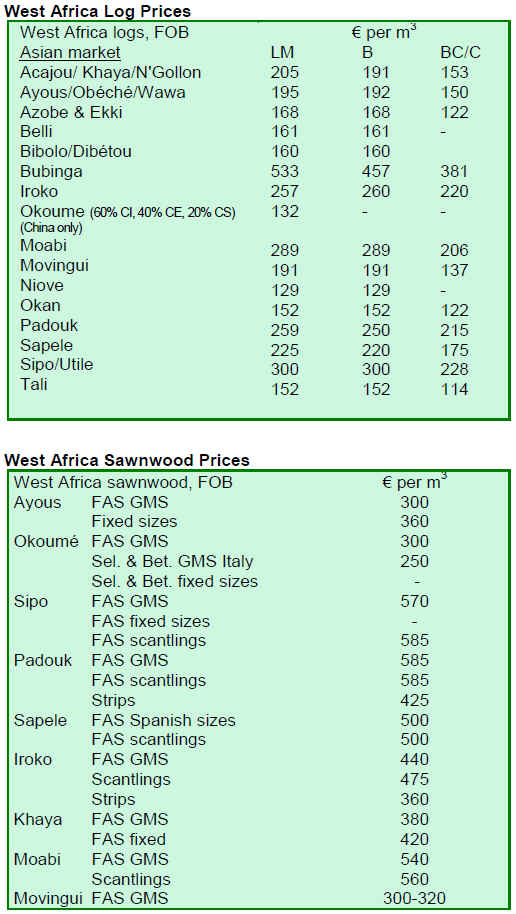
2. GHANA
President appoints new Minister of Lands and Natural
Resources
Following the successful transition to Ghana¡¯s new
government administration, the new President John Evan
Attah Mills has appointed Mr. Collins Dauda as the new
Minister of Lands and Natural Resources. Mr. Dauda was
a member of the Parliamentary Select Committee of the
Fourth Republic on Lands and Forestry. The new Minister
was among the first batch of 11 nominated by the
President for consideration by parliament for appointment.
Prior to gaining parliamentary approval, Mr. Dauda
successfully answered questions on forestry, including on
the fast depletion of the country¡¯s forest resources and
rising incidence of bushfires. In his answers to the vetting
committee, he indicated the main focus of his new
appointment would be to develop plantations to replenish
stocks of the country¡¯s raw materials.
Ghanaian exports to the US slump
Though the US continued its dominance as the most
lucrative destination for Ghana¡¯s kiln-dried lumber and
rotary veneer, the recent economic crisis has slumped
demand for Ghana¡¯s timber products, particularly
mahogany and odum. This has forced some of Ghana¡¯s
lumber and veneer prices down. Market analysts were
hopeful, however, the economic downturn would be shortlived
and avoid negative impact on business and industrial
employment.
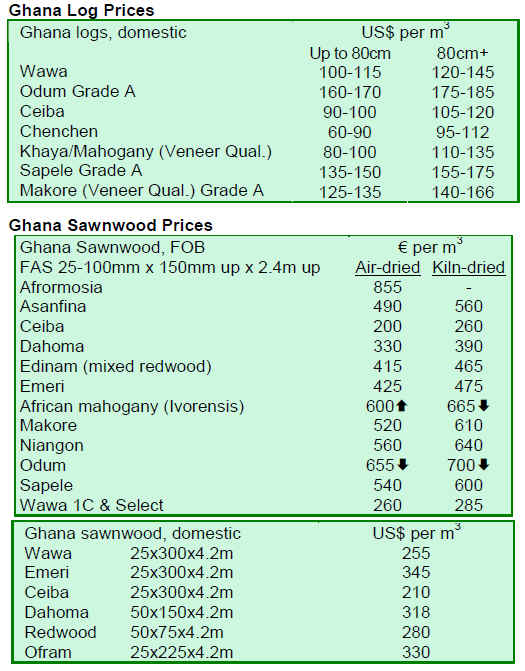
3.
MALAYSIA
Malaysia¡¯s commodity export earnings top USD112 billion
Malaysia¡¯s Plantation Industries and Commodities
Minister Datuk Peter Chin Fah Kui said the country¡¯s
commodity exports topped USD112 billion in 2008, a
26.7% increase from 2007, mostly due to high prices of
palm oil in 2008. According to Bernama, earnings for two
commodities declined, one of which was timber and
timber products. Malaysia¡¯s earnings from timber and
timber products declined 0.66%, from RM22.65 billion in
2007 to RM22.5 billion in 2008.
In other domestic economic news reported in The Sun
Daily, Deputy Finance Minister Datuk Kong Cho Ha
announced the government¡¯s intentions to approve a
¡®mini¡¯ economic stimulus package of at least RM30 billion
(USD8.17 billion) to generate greater economic and
business activities in the country. He said the stimulus
would help address the increasing lay-offs in the country,
which were expected to affect 60,000 workers. Kong also
remarked that the lack of investor confidence was causing
liquidity problems.
Malaysia gives ASEAN fund a boost
Malaysia will contribute USD3.4 billion (RM12.23
billion) in loans as part of a multi-billion dollar effort to
assist ASEAN countries affected by the global economic
downturn, reported The Star. The funds will be available
as loans to member countries when the initiative is
endorsed at the next meeting of ASEAN finance ministers
in Bali this May. China, Japan and South Korea agreed to
contribute to the initiative, raising the total amount of
funds from USD80 billion to USD120 billion, with
ASEAN countries contributing 20% (USD24 billion) of
the fund. Cambodia, Myanmar, Laos, Vietnam and Brunei
will each contribute 5% of their national reserves to the
initiative.
Prices for Malaysian timber products remain depressed
Prices of Malaysian timber products remained low even as
timber traders resisted further price reduction. Although
timber traders continued to have idle inventories, many
were holding out for the US economic stimulus plan and
mortgage bailout plan to take effect and move the industry
forward. However, some timber traders believed it would
take at least six months or more to see any real business
activities returning to the industry.
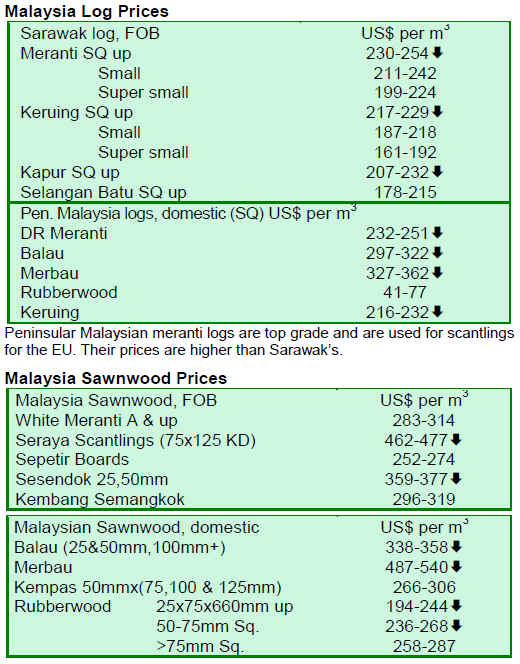
4.
INDONESIA
Japan extends financial support for Indonesian economy
The Japan Bank of International Cooperation (JBIC) will
provide financial support of USD1.5 billion to Indonesia
as part of a guarantee on the sale of yen-denominated
¡®samurai¡¯ bonds, reported The Jakarta Globe. Japan will
also assist in stabilizing the Indonesian economy by
raising the size of funds available though a bilateral
currency swap agreement started under the Chiang Mai
Initiative, in response to the 1997 Asian Financial Crisis.
The agreement will allow up to USD12 billion in currency
swaps to fortify Indonesia¡¯s foreign reserves, which
currently stand at USD50.87 million.
In other bilateral discussions, Indonesia¡¯s President Mr.
Susilo Bambang Yudhoyono met with US Secretary of
State Hillary Clinton during her recent visit to Indonesia,
reported Antara News. The Indonesian President stressed
to Secretary Clinton the need for the US and Indonesia to
maintain economic momentum as the global economy
continued to decline. During calendar year 2008, the
volume of trade between Indonesia and the US stood at
USD20.1 billion. US investments in Indonesia amounted
to USD10.6 billion.
Government orders workers to buy Indonesian-made products
Federal government workers have been ordered to buy
Indonesian-made products to stem a decline in exports,
indicated The Bali Times. The new regulations and
penalties for non-compliance will be drafted by the
Ministry of Industry and Trade. Indonesian exports for
2008 fell 21% compared to December 2007 levels, the
sharpest drop in seven years.
Prices of Indonesian timber products remain in the doldrums
Prices of Indonesian timber products continued to decline
as sawmills in most major cities across Indonesia refused
to purchase more logs. Many sawmills were void of
inventories as they awaited the prospect of foreclosure.
With buyers few and far between, the business situation
for plywood and panel products was becoming grimmer.
The hardest hit might be community-based furniture
manufacturers, a major source of Indonesian furniture, as
orders have mostly dried up since January 2009. Coupled
with rampant unemployment, entire communities were
facing the prospect of spiraling into bankruptcy.
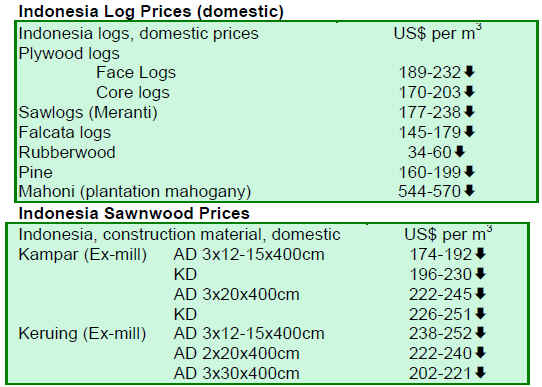
5.
MYANMAR
Shipments at virtual standstill as market moves
sluggishly
Shipments are almost at a standstill since early this month,
after MTE¡¯s decision to stop shipping FOB for direct sales
contracts following a highly publicized narcotics incident
(see TTMR 14:3). Only tender lots will be sold FOB, with
the remaining goods being purchased Ex-Works
(Mill/Depot/Factory). After the recent narcotics incident,
all shipments continue to be checked thoroughly by the
authorities before they are loaded on board ocean going
vessels.
Many experts are convinced that MTE had not been
involved in the recently publicized drug incident.
Nevertheless, since MTE does not desire a repeat of such
an incident, the decision to sell on an Ex-Works basis will
remain unchanged until further notice. It is expected that
such an approach would remove MTE¡¯s liability for the
contents of shipments from private buyers that might be
involved in any future shipping incidents.
The market has been slow moving due to the current
economic downturn and the new system of sales. Tender
prices were generally up mainly because of the quantity
and grades of logs sold.
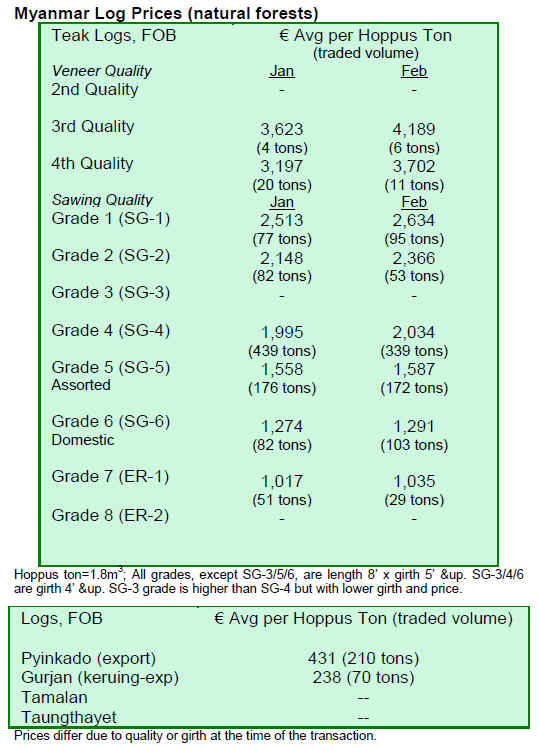
6. BRAZIL
Mato Grosso uses satellites to fine violators
Mato Grosso has started using an innovative method to
detect illegal logging and deforestation through satellite
imaging to apply fines to violators, reported Globo
Amazônia. Based on the locations of deforestation
detected by INPE, a team checks the satellite data, which
is then cross-checked with information on registered rural
properties at the State Secretary of the Environment
(SEMA). Fines are imposed when a property is registered
with SEMA. In cases where deforestation has taken place
within a legally protected Permanent Protection Area or
Legal Reserve, a fine is issued and sent to the landowner
by mail.
The weakness of applying a ¡®fine from a distance¡¯ is that
SEMA has listed only properties with an environmental
license registered in its control system. Only 25% of areas
subject to licensing are registered in the system and,
because of this, the likelihood of landowners committing
environmental crimes is low. When deforestation is
detected outside a registered area, an inspection team visits
the site. In this circumstance, the chances of finding the
violator and collecting payment of the fine by the violator
is much lower.
Despite that most properties are not registered at SEMA,
the head of SEMA is optimistic about the future, since any
bank loan requires an environmental license. The area of
land registered has increased largely after the National
Monetary Council (CMN) issued a resolution requiring
landowners to have environmental licenses before
obtaining rural bank loans. If all properties are registered,
inspections could all be done by satellite.
Multi-million illegal timber operation detected in Par¨¢
A large-scale multi-million illegal logging operation was
detected in the state of Par¨¢, where most logging
operations take place in the Amazon region. According to
Gazeta do Povo, the illegal operation started at the end of
2008, when the Environment Secretary of State (SEMA)
issued logging permits in government settlement areas.
According to local sources, public servants of SEMA
received bribes in exchange for logging permits. The
SEMA-issued permits were used to cover up illegal timber
operations, making these appear legal. The entire
operation could generate 109,000 m³ of timber worth
about BRL30 million.
The head of SEMA had acknowledged the fraudulent
paperwork. According to investigators, data was
manipulated, leading to the suspension of projects under
suspicion and allowing SEMA officials to collect field
evidence to find the engineers liable for the wrongdoings.
SEMA had confirmed that several companies have already
illegally sold over 10% of the total authorized felled logs.
The SEMA official who authorized the logging had denied
any involvement or responsibility for the scam, saying it
would be impossible to thoroughly review more than
80,000 cases signed during the year.
Alta Floresta wood exports plunge 34% in 2008
S¨® Not¨ªcias reported on the municipality of Alta Floresta¡¯s
wood products statistics in 2008, noting it was one of the
major timber producers in the Brazilian Amazon. Alta
Floresta closed 2008 with a 32.1% drop in wood product
exports. According to the Ministry of Development,
Industry and Foreign Trade, exports of various timber
products from January to December 2008 reached
USD14.2 million, compared to the USD20.9 million
recorded in 2007. Exports of timber products were
substantially reduced, including of ¡®non-coniferous parts¡¯
(-22.9%), which were worth USD11.8 million.
Exports of sawnwood cut into sheets (thicker than six
millimeters) were USD1.9 million, 52.6% lower than in
2007, when total exports reached USD2.9 million. On the
other hand, exports of some items such as Ip¨¦ parts
increased (116%) in 2008 compared to 2007. The largest
share of exports in 2008 went to the US (USD7.5 million),
although overall sales dropped 28.5% from 2007 levels.
Alta Floresta exported USD2.2 million to Spain in 2008, a
fall of 29.8% compared to 2007. The exception to the
slump in exports was Israel, which registered imports of
USD1 million, a 28.8% jump from 2007 levels.
Brazil¡¯s January 2009 exports slide by more than 50%
Brazil¡¯s wood products exports (except pulp and paper)
dropped 51.6% by value compared to the same period in
2008. The charts below show the volume and value of
Brazil¡¯s exports for the month of January 2009 compared
to the same month a year earlier:
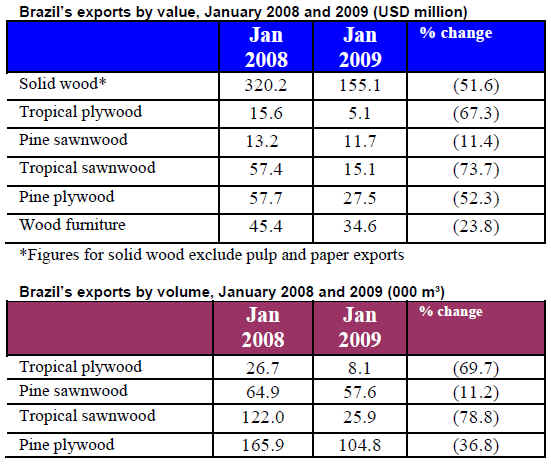
Furniture sector faces increasing layoffs
According to the Jornal do Com¨¦rcio, the Southern
Brazilian state of Rio Grande do Sul saw revenue from
furniture exports decline 34.3% compared to 2008. This
was expected to trigger layoffs in large exporting
companies. The Furniture Industry Association of Rio
Grande do Sul (MOVERGS) has said a reverse in the
current situation will be difficult in the first half of 2009.
Consequently, the Association has encouraged controlling
expenditures and reducing expenses to save energy as well
as shifting a large part of production to the domestic
market.
The drop in sales since the end of 2008 has already
signaled factories to slow production. If the market does
not pick up, companies will need to review their goals and
layoffs may be necessary. Increased competitiveness of
products due to the recovery of exchange rates is not
occurring because there are fewer export orders. This
situation may explain the reason why the drop in sales
from January 2008 to 2009 (35% from USD18.3 million to
USD11.9 million) is greater than that of Brazil¡¯s overall
exports in the sector (27.4%). Until October 2008, the
growth in exports of the state¡¯s furniture sector had been
above the national average. However, export orders from
the US, EU and Latin American countries that are major
export destinations of Brazilian furniture have all
decreased. According to the Secretary of Foreign Trade
(SECEX), Argentina¡¯s exports fell 33.6% even though it
was the second largest buyer of Brazil¡¯s furniture in
January 2009 and was the main intra-regional trading
destination for Brazilian furniture in 2008.
The increase in competitiveness of Brazilian products in
the US market due to the US dollar/Brazilian real
exchange rate has been negated by a decreased in demand.
From February to March 2009, some administrative
measures are expected to be adopted such as a reduction in
working hours and possible layoffs. Furniture companies
cannot abandon the foreign market because the cost of
doing so is high. Therefore, they will continue to review
their investments and projects needed to keep the industry
running.
APEX promotes exports at Abimad Fair
During the recent Brazilian Association of Fine
Decoration Furniture Industries (Abimad) Fair, held from
12-15 February 2009, the Brazilian Agency for Export and
Investment Promotion (Apex-Brazil) launched an
exhibition space called the ¡®Exporter House¡¯, showcasing
a range of timber products and services oriented to
international trade. The idea is to facilitate daily activities
of companies that operate abroad, enabling them to
become major exporters, noted Gazeta
Mercantil/Sindm¨®veis held a business roundtable that
brought together 36 buyers from 21 countries and 45
Brazilian high standard furniture industries before the
official fair began. The meeting generated more businesses
in 2009 than in 2008.
The business fair brought to Brazil importers from the
United Arab Emirates, one of the target markets of Apex.
The US, Italy and Spain are countries that Apex has
already been working with. Lately, the Brazilian high
standard furniture has attracted the attention of African
and Caribbean importers. Angola, Mozambique, South
Africa, Venezuela, Chile and Argentina are relatively new
export destinations that have the potential to grow 20-
30%. China, a major competitor of Brazilian furniture
abroad, has increased its prices by nearly 20%. The
exchange rate has improved Brazil¡¯s competitiveness in
the market, but prices have still dropped by up to 30%.
Additionally, Apex Brazil, in partnership with the Export
Project of Furniture Components and Accessories ¨C
Orchestra Brazil, offers support for international
expansion of markets through activities ranging from new
market prospects to supporting furniture fairs abroad. In
April 2009, there will be an opportunity for companies
associated with furniture unions to learn about the reality
of the Indian market which is gradually growing within the
global economy. Visits to mills, business meetings and
seminars with companies in the sector are planned, in
addition to visits to furniture retailers.
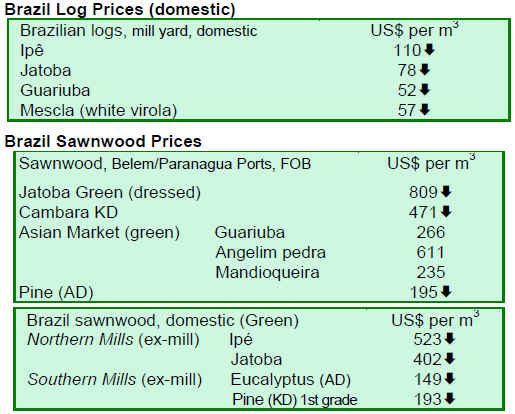
7.
PERU
Peru¡¯s wood exports grow 3% during 2008
New data from the Export Association of Peru (ADEX)
shows wood exports from January through December
2008 grew 3% by value, with exports rising to USD221.9
million, up from USD215.4 million in 2007.
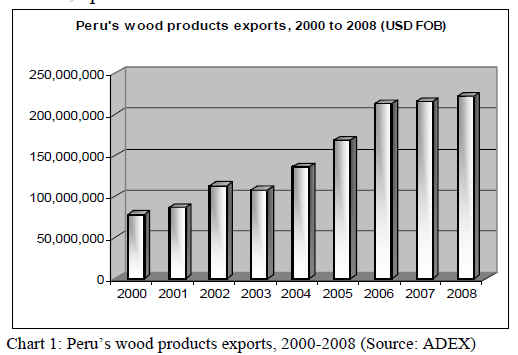
Exports in the month of December 2008 were USD6.24
million less than exports in the same month of 2007. The
volume exported to Mexico, China and the US diminished
in December 2008. Peru¡¯s exports of wood products have
been decreasing from October 2008 as a result of the
economic slowdown.
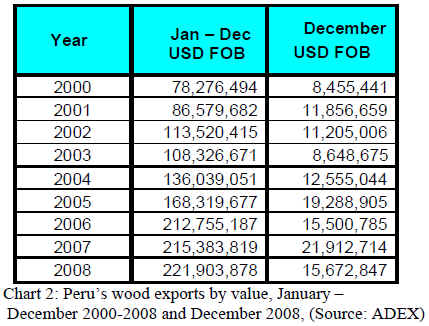
Sawnwood was the largest export item, representing
44.7% of sector exports. Exports from January to
December 2008 were USD99.26 million, a drop of 10.7%
compared to the same period in 2007, when exports were
USD111.5 million. The main market destinations for this
sector¡¯s products were Mexico, the US, China and the
Dominican Republic, which accounted for 49.6%, 22.7%,
11.33%, 10.9% of sawnwood exports, respectively.
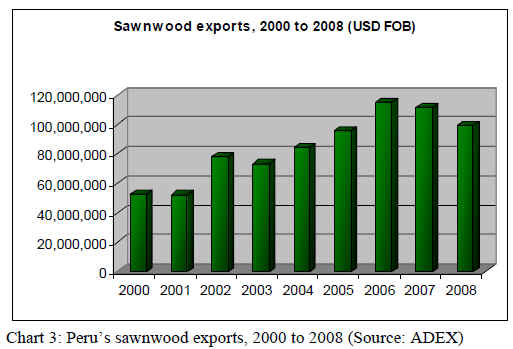
Semi-manufactured products represented 31% of Peru¡¯s
total wood sector exports. Exports in January to December
2008 were valued at USD69.5 million, while exports for
the same period in 2007 were valued at USD55.5 million,
a 25.2% rise from 2007 levels. Exports of semimanufactured
products in December 2008 decreased by
USD216,300 from December 2007 levels. The gains were
largely due to the progressive growth of exports such as
decking, for which China had been the main destination
market.
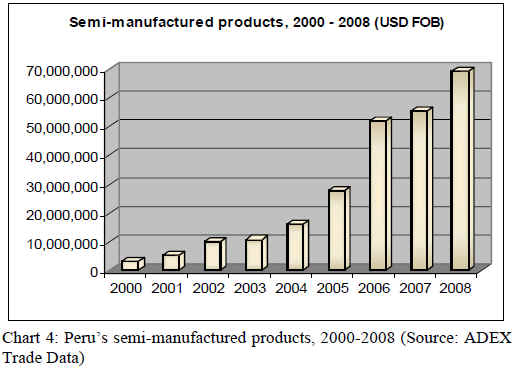
Veneer and plywood exports for the January to December
2008 period were USD27.4 million, a 19.7% jump from
the same period in 2007. Exports from the sub-sector
showed Mexico as the main market destination for Peru¡¯s
exports (88.6%), followed by Venezuela (7.4%) and
Guatemala (1.5%).
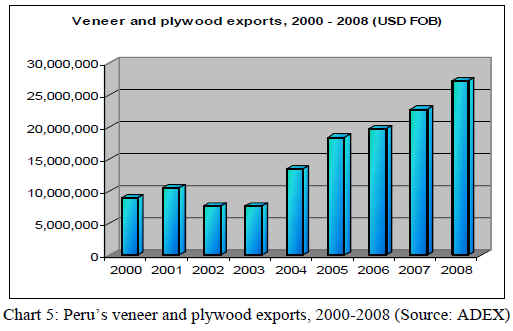
Furniture exports were valued at USD9.3 million during
the period, a 26.6% decrease from the same period in
2007. The main market destinations for these products
were the US (58.7%), followed by Italy (21.5%). It is also
worth noting the growth of imports by the regional
markets, the main countries being Venezuela and
Colombia.
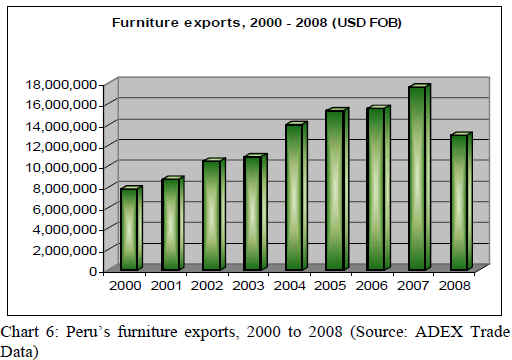
From January to December 2008, exports were
concentrated in three markets, representing 83.7% of total
wood products exports. Mexico accounted for 35% of
exports in the sector, growing 10% compared to the
previous year, followed by China with 28%, a growth of
49% over the same period. The US was the third largest
destination market (20%), falling 33% in contrast to 2007.
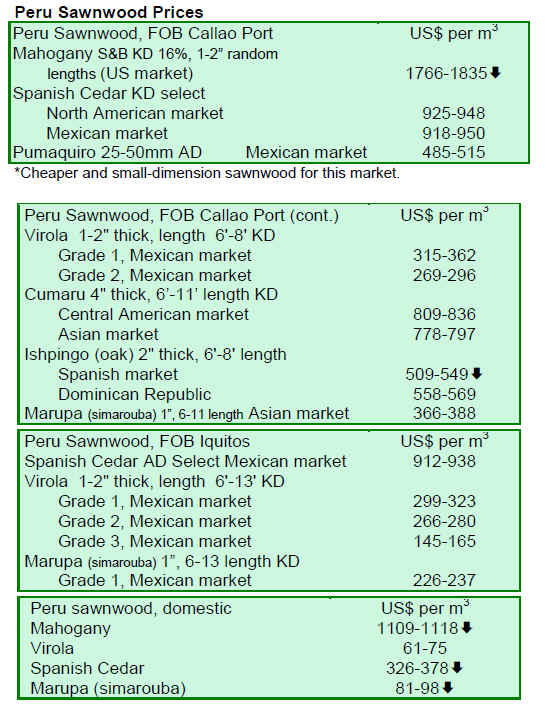
8. BOLIVIA
Fifth Business Roundtable attracts participants from
over 20 countries
Bolivia¡¯s Fifth Business Roundtable of the Wood Industry,
to be held on 26 and 27 March 2009, is expected to draw
participants from over 20 countries. The international
round table is organized annually by the Bolivia Forestry
Chamber (CFB) in coordination with EXPOFOREST, to
be held from 25-28 March in Santa Cruz de la Sierra,
Bolivia.
More than 25 global companies have confirmed their
participation at the Fifth Business Roundtable of the Wood
Industry. The CFB has committed participation from
various local entrepreneurs from La Paz, Cochabamba,
Tarija, and eastern Bolivia. Indigenous communities
engaged in forestry operations have also registered as in
previous years.
The event aims at opening business opportunities to
buyers and sellers of lumber, doors, furniture, as well as
shipping companies and other providers of timber and
wood-related goods and services. It is anticipated that
from 26-27 March, the value of business will exceed
USD27 million achieved last year. Below are results from
the previous years¡¯ events:
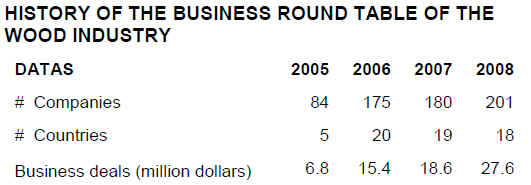
The Fifth Business Roundtable of the Wood Industry has
the support of cooperation organizations such as USAID
Bolivia, CADEFOR, ITTO and WWF. Registration
information on the Business Roundtable can be found at:
www.cfb.org.bo/cfbferias/rueda2008/inscripcion.htm.

9. Mexico
City of Leon raises 4 million pesos for forest
conservation
The National Forest Agency (CONAFOR), the city
council of Leon and the Government of the State of
Guanajuato signed the ¡®Agreement of Collaboration to
Promote the Market of the Environmental Hydrologic
Services through Concurrent Funds¡¯, through which 4
million pesos will be used for the conservation of 1,450
hectares in the Sierra Lobos. The Municipality of Leon
will contribute 1 million pesos, the Government of the
State of Guanajuato will invest a similar sum and
CONAFOR will contribution 2 million pesos.
The regional manager of CONAFOR, Altamirano
Marmolejo, explained the 4 million pesos would be
granted to the beneficiaries, as long as the forest cover of
the benefiting area remains intact or improves. For each
hectare of forest or conserved forest, 552 pesos will be
paid over five consecutive years. The condition for this
payment is that a minimum of 50% of forest cover is
conserved.
This agreement is considered the first step to helping the
municipality conserve forest resources, since investment is
necessary to generate local markets for environmental
services so that the citizens, as users, pay the owners of the
forests for the environmental service the forest ecosystems
provide. Nearly 1,450 hectares of land will be designated
for a payment for hydrologic environmental services
scheme.
A representative of the government explained how the
government of Mexico was committed to promoting forest
conservation, jungles and vegetation of barren zones and
the services they provide, as well as to stimulate markets
for environmental services. As a result of the creation of
the program on payment for environmental services in
2003, about 1.74 million hectares of forests, jungles and
vegetation of barren zones of the country have been
involved in the scheme.
10.
Guyana
Guyana¡¯s export prices jump
Export prices for most of Guyana¡¯s Forest Products
recorded significant increases over the previous fortnight¡¯s
average prices, with log prices recording the smallest gains
for the main products exported. Log prices recorded an
average price rise of 6% compared to the previous
fortnight. Dressed lumber prices rose 9% while undressed
lumber prices were 66% higher than those recorded over
the previous fortnight. Export prices for round timber piles
also recorded gains, with prices increasing 56%.
A year-to-date comparison in average prices for the main
forest products exported over the corresponding period in
2008 revealed prices were significantly above those
reported in 2007. The highest increases in average prices
were recorded for roundwood, with a jump of 66% in price
during the corresponding period of 2008. This was
followed by a rise of 56% in average prices for logs, 41%
for splitwood, 19% for sawnwood and 16% for plywood.
Log exports continued to be substantially below 2007
levels, with a 51% decline in export value for the first
fortnight of 2009. The recently implemented log export
policy continued to show strong signs of deterring log
exports to benefit higher levels of raw materials available
locally for further processing and processed log exports.
Dressed lumber continued over the fortnight to be the
leading revenue earner for Guyana, surpassing the total of
the corresponding period for 2008 corresponding by 5%.
Other trends from the last fortnight continued, with
shingles exports following dressed lumber as the second
highest revenue earning product.
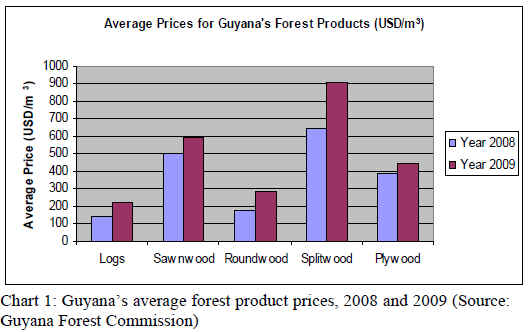
ITTO kiln drying project receives strong stakeholder
backing
Guyana commenced the implementation of a recently
financed ITTO project on value-adding and kiln drying of
commercial timbers by small-scale community saw millers
in Guyana. The activities started with country-wide
consultations to inform an initial assessment report, which
seeks industry-level inputs on the establishment of the kiln
facilities in the most appropriate manner and considers
issues of capacity, species utilization, product type and
location.
In January 2009, a total of 155 forest industry stakeholders
across Guyana were consulted. The consultations reflected
a strong interest in moving towards added value
production and a strong enthusiasm for engaging in the
venture of kiln drying, which is seen as a vital and
necessary starting point to adding value in downstream
processing.
Guyana¡¯s forest sector in 2008 has shown a rapid shift to
more downstream production and this project therefore
comes at a strategic time to support this shift. The project
targets small and medium-size community forest
enterprises and aims to facilitate technology and
knowledge transfer in kiln drying to this segment of
Guyana¡¯s forest industry.
Following the completion of the initial assessment report,
the most suitable kilns will be procured and installed at
selected locations for use by small and medium-size
community operators. Capacity building for community
operators at this stage will also be undertaken to improve
the operation and maintenance of kiln dryers and drying of
Guyana¡¯s timber species.
With resources dedicated to building the technical and
resource capacity of community stakeholders in the forest
sector, Guyana hopes to strengthen the potential of
community forest producers to better access and retain
lucrative markets for high value tropical forest products.
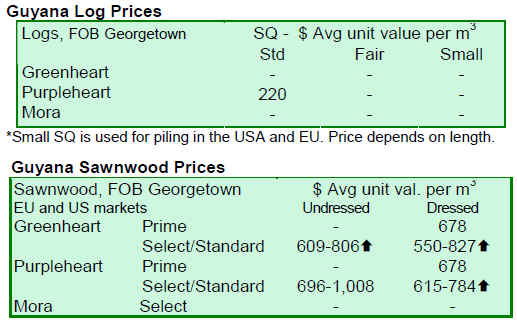
|